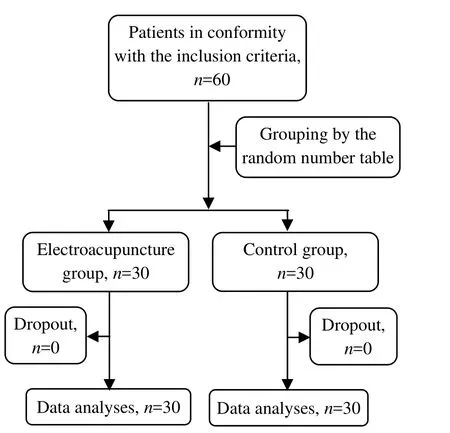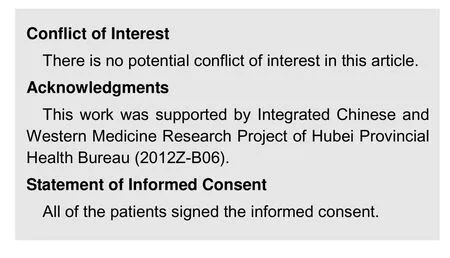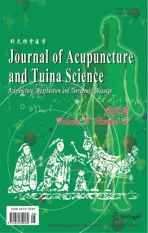Effect of Electroacupuncture on Anxiety and Craving in Heroin Addicts During Detoxification
2013-07-18MuJingpingLiuLiLiaoHengWuHuanganXuPing
Mu Jing-ping, Liu Li, Liao Heng, Wu Huan-gan, Xu Ping
1 Taihe Hospital Affiliated to Hubei Medical College, Shiyan 442000, China
2 Shanghai University of Traditional Chinese Medicine, Shanghai 201203, China
Effect of Electroacupuncture on Anxiety and Craving in Heroin Addicts During Detoxification
Mu Jing-ping1, Liu Li1, Liao Heng1, Wu Huan-gan2, Xu Ping2
1 Taihe Hospital Affiliated to Hubei Medical College, Shiyan 442000, China
2 Shanghai University of Traditional Chinese Medicine, Shanghai 201203, China
Objective: To observe the effect of electroacupuncture at Jiaji (EX-B 2) points for anxiety and craving in heroin addicts during detoxification.
Methods: A total of 60 cases were randomized into an electroacupuncture group and a control group, 30 in each group. Cases in the electroacupuncture group were treated with electroacupuncture at Jiaji (EX-B 2) points, whereas cases in the control group were treated with Methadone and Doxepin. Then scores were graded using Zung self-rating anxiety score (SAS) and self-made visual analogue scale (VAS). The assessment was conducted once a day to record the adverse reactions.
Results: After treatment, the SAS and VAS scores in the electroacupuncture group were significantly lower than that in the control group (P<0.01).
Conclusion: Electroacupuncture at Jiaji (EX-B 2) points can effectively alleviate anxiety and craving intensity in heroin addicts during detoxification.
Acupuncture Therapy; Electroacupuncture; Heroin Dependence; Substance Withdrawal Syndrome; Anxiety
According to the2011 Annual Report on Drug Control in China, there were a total of 1.545 million registered drug users at the end of 2010, and 69% (i.e., 1.065 million) of these drug users were heroin addicts. It’s known to all that drug abuse can further lead to illegal crimes and the spread of many diseases including HIV-AIDs. This will not only affect people’s well-being but also have great social and economic impact. As semisynthetic opioids, heroin is often preferred for drug users. Frequent and regular use is associated with physical dependence.
After detoxification, heroin addicts will experience protracted withdrawal symptoms such as insomnia, anxiety, depression and pain[1]. Left untreated, these symptoms may persist, cause great physiological and psychological impact, and contribute to relapse into drug use. Currently benzodiazepine, sedative-hypnotic and antianxiety medications are mainly used for post-acute heroin withdrawal symptoms including insomnia and anxiety[2-3]. However, the main problem of the chronic use of these medications is the development of tolerance and dependence. This may result in new drug dependence and lengthen the withdrawal period. In addition, they fail to achieve specific treatment effects. In order to investigate the effect of electroacupuncture at Jiaji (EX-B 2) points for anxiety and cravings in heroin addicts during detoxification, we treated patients with electroacupuncture at Jiaji (EX-B 2) points between January 2009 and December 2011 and compared it with Methadone alone for detoxification. The report is now summarized as follows.
1 Clinical Materials
1.1 Diagnostic criteria
This is based on the fourth edition ofDiagnostic and Statistical Manual of Mental Disorders(DSM-IV) criteria for opioid withdrawal. A history of heroin addiction and acute opioid-withdrawal symptoms after cessation of opioid use; and positive urine drug test for opioids or positive Naloxone challenge test (NCT).
1.2 Inclusion criteria
Those with apparent withdrawal symptoms and cravings such as generalized body ache, anxiety and insomnia; a history of drug use for 3 months or longer and daily drug dose <3 g/d; men or women aged between 18 and 55 years old; having received no other detoxification therapies during the last 3 months; willing to sign the informed consent.
1.3 Exclusion criteria
Those with complications of severe organic diseases involving heart, liver and kidney; patients with severe primary hematopoietic system conditions; psychotic patients; those with complications of pulmonary tuberculosis and HIV infection; severe malnutrition subjects; women during lactation or pregnancy; and those who failed to cooperate or was involved in other drug experiments.
1.4 General data
A total of 60 cases, who were willing or forced to receive detoxification between January 2009 and December 2011 in Drug Rehabilitation Center of Shiyan Public Security Bureau, were randomized into an electroacupuncture group and a control group by the random digits table, 30 cases in each group. There were no statistical differences in gender, age, drug dose and time period of drug use between two groups (P>0.05), so the two groups were comparable (table 1). The clinical managements of the two groups are shown in Fig.1.
2 Treatment Methods
2.1 Electroacupuncture group
Points: Bilateral Jiaji (EX-B 2) points at the level of T5-7and Shenshu (BL 23).
Method: After routine skin disinfection, insert 1-1.5 cun into Jiaji (EX-B 2) points (T5-7) obliquely and 1.5 cun into Shenshu (BL 23) perpendicularly using disposable filiform needles of 0.35 mm in diameter and 40 mm in length. Upon arrival of needling sensation, connect Jiaji (EX-B 2) points at the level of T7and Shenshu (BL 23) on the same side with G6805-2 low-frequency electronic impulse device (manufactured by Shanghai Medical Equipment Factory), using a sparse wave, frequency of 5 Hz and stimulation intensity of 5 mA. The treatment was conducted 20 min, once a day, for 2 weeks.

Fig.1 Clinical management flow chart
2.2 Control group
Patients in the control group were given Methadone and Doxepin for two weeks: 10 mg of Methadone for each dose, 3 doses a day and 25 mg of Doxepin for each dose, 3 doses a day.
3 Therapeutic Efficacy Observation
Clinical treatment, rating scale evaluation and statistical analysis in this study were completed by different personnel.

Table 1. Between-group comparison of general data
3.1 Observation indexes
3.1.1 Self-rating anxiety scale (SAS)[4]
The self-rating anxiety scale (SAS) is a 20-item self-report assessment device built to measure anxiety levels. Each question is scored on a scale of 1-4. Fifteen of 20 items go in order of 1 to 4; however, 5 items are scored in the opposite order (since they represent positive/non-anxiety statements). A higher score indicates a higher level of anxiety. A standard score can be calculated by the total raw score of 20 items multiplying 1.25 (an integral number).
3.1.2 Craving intensity[5]
The visual analog scale (VAS) was used to collect information on self-reported craving intensity. The craving intensity was scored on a scale of 1-4.
Extreme craving: 10.
Moderate craving: 7.
Almost no craving: 3.
No craving at all: 0.
The patient places a mark on a line according to one’s own craving intensity. The VAS was assessed respectively before and after treatment using the same instructive words by personnel who were not involved in clinical treatment. The personnel all received 1-week training before the study began.
3.2 Statistical method
The SPSS 14.0 version software package was used for statistical analysis,t-test for measurement data and () for expression.
3.3 Results
3.3.1 SAS comparison between the two groups
Before treatment, there was no between-group statistical difference in anxiety level (P>0.05). After treatment, SAS scores in both groups were significantly reduced (P<0.05) and the electroacupuncture group showed a better effect than the control group (P<0.01) (table 2).
Table 2. Between-group comparison of SAS scores (, point)

Table 2. Between-group comparison of SAS scores (, point)
Note: Self-comparison with result before treatment, 1)P<0.05; compared with the control group after treatment, 2)P<0.01
Electroacupuncture 30 48.96±5.61 37.75±6.181)2)Control 30 49.45±4.58 42.33±5.211)
3.3.2 Craving VAS comparison between the two groups
Before treatment, there was no between-group statistical difference in craving level (P>0.05). After treatment, VAS scores in both groups were significantly reduced (P<0.05) and the electroacupuncture group showed a better effect than the control group (P<0.01) (table 3).
Table 3. Between-group comparison of craving VAS scores (, point)

Table 3. Between-group comparison of craving VAS scores (, point)
Note: Self-comparison with result before treatment, 1)P<0.05; compared with the control group after treatment, 2)P<0.01
Electroacupuncture 308.63±1.52 2.33±1.021)2)Control 308.71±2.03 4.57±2.111)
4 Discussion
A series of somatic symptoms and mental disorders can occur after long-term inhaling opioids including heroin. Since it particularly affects the central nervous system, heroin addiction can induce an intense euphoria, greatly consume one’s physical strength, compromise the immune function, severely damage the heart and brain tissue, and even result in death. In addition, heroin addicts may experience mental disorders and become paranoid and aggressive. Some studies suggest that drug dependence is a chronic recurrent brain disease resulting from the interaction between drug abuse and brain reward system, mainly manifesting as a sense of compulsion to take the drug and persistent cravings[6].
A successful detoxification needs to address anxiety and depressive symptoms[7-8]in heroin addicts. Although Methadone can substantially relieve somatic withdrawal symptoms, it does not help much with the intense cravings. As a result, the persistent cravings can contribute to relapse of drug use. For successful detoxification and prevention of relapses, it is extremely important to relieve or eradicate the anxiety and cravings in heroin addicts.
Previous studies done by our research team have suggested that 72.7% of heroin addicts had tenderness spots around the spinous processes and the pain gradually relieved upon alleviation of somatic symptoms[9-10]. Based on pattern identification and frequencies of points reported over the recent years, we selected Shenshu (BL 23) and Jiaji (EX-B 2) points at the level of T5-7. Located close to Shendao (GV 11) and Xinshu (BL 15), Jiaji (EX-B 2) points of T5tranquilize heart-mind; located close to Dushu (BL 16) and Lingtai (GV 10), Jiaji (EX-B 2) points of T6unblock the Governor Vessel, regulates qi and relieves pain; located in between Geshu (BL 17) and Zhiyang (GV 9), Jiaji (EX-B 2) points of T7soothe liver qi and circulate blood; and Shenshu (BL 23) tonifies the kidney and strengthens the lumbus.
By using VAS and SAS rating scales, this study observed the effect of electroacupuncture at Jiaji (EX-B 2) points for heroin addicts’ post-detoxification craving and anxiety and compared with the control group. The dynamic observation under less psychological stress can show their real cravings andmental state. Research findings have shown that electroacupuncture at Jiaji (EX-B 2) points can substantially alleviate heroin addicts’ craving and anxiety during detoxification. According to the neurosis theory in cognitive psychology, anxiety patients often have physical or mental perception of threat or danger; whereas depressive patients often have pessimistic thoughts about themselves, their future and the whole world. For heroin addicts, post-detoxification anxiety is closely associated with post-withdrawal somatic symptoms and sleep disorders including general pain, weakness of the four limbs, insomnia, early morning awaking and interrupted sleep. Acupuncture can substantially improve somatic discomfort and sleep disorder that may contribute to or aggravate anxiety.
Some studies suggest that acupuncture can alleviate post-withdrawal anxiety in heroin addiction rats, regulate their hypothalamic-pituitary-adrenal (HPA) system activity, and relieve their mood swings following heroin withdrawal[11-12]. This underlying mechanism can possibly be explained by that acupuncture can help regulate the functions of HPA system, especially the contents of dopamine in heroin-withdrawal rats.

[1] Song XG, Xu GL, Tang ZL, Gu Y, Zhang H, Chen XM, Huang CS. Clinical observation on ear acupuncture for protracted heroin withdrawal symptom in 70 cases. Zhongguo Zhongyiyao Keji, 2006, 13 (3): 189-190.
[2] Xia Y, Peng JJ, Lu YY, Yang W, Hu TC, Su Z. Clinical research of protracted withdrawal syndrome treatment with phenytoin in heroin addicts. Zhongguo Yaowu Lanyong Fangzhi Zazhi, 2006, 12(2): 79-80.
[3] Liu DC. Therapeutic efficacy analysis on doxepin for anxiety and craving during detoxification in 140 heroin addicts. Guangxi Yixue, 2008, 30(4): 510-512.
[4] Wu JM, Lin JH, Luo YF, Li J. Acupuncture Ameliorating Psycho-craving for Heroin Addict. Chengdu Zhongyiyao Daxue Xuebao, 2002, 25 (3): 5-6.
[5] Wang XD, Wang XL, Ma H. Mental Health Assessment Rating Scale. Beijing: Periodical Office of Zhongguo Xinli Weisheng, 1999: 235-237.
[6] Li X. Heroin dependence event-related potential and neuropsychological research advance. Linchuang Xinshen Jibing Zazhi, 2007, 13(6): 567-569.
[7] Li ZQ, Song KX, Song XJ. Effect of systemic psychobehavioral therapy for mental health problems of drug abusers under detoxification. Zhongguo Yaowu Yilaixing Zazhi, 2006, 15(2): 54-58.
[8] Wang ZG, Bai YG, Zhao ZL, Zhang XW, Chen WG, Ma L. SAS application outcome analysis in addicts of snorting heroin. Zhongguo Yaowu Lanyong Fangzhi Zazhi, 1998, (2): 11-14.
[9] Hu J, Lu Y, Xin YH, Li Y, Zong L, Zhao SX, Li S. Observation on positive reaction points on the spine in heroin dependence. Zhongguo Zhenjiu, 2000, 20(10): 87-89.
[10] Mu JP, Liu L, Hu J, Xu P. Clinical study on electroacupuncture at Jiaji (EX-B 2) for interfering protracted withdrawal syndrome in the patient of heroin dependence. Zhongguo Zhenjiu, 2005, 25(9): 599-602.
[11] Wang GH, Pan GS, Guo L, Han YC. Effect of acupuncture on the hypothalamus-pituitary-adrenal system in heroin withdrawal rats. Zhongguo Yaoli Xue Tongbao, 2012, 28(3): 402-406.
[12] Sun YZ, Wei Z, Ma J, Wang MM. Effect of electroacupuncture on behavior and DA content in rats with morphine withdrawal-induced anxiety. Shanghai Zhenjiu Zazhi, 2011, 30(5): 337-339.
Translator: Han Chou-ping
R246.6
A
Date: April 10, 2013
Author: Mu Jing-ping, M.D., vice chief physician.
E-mail: mjpll@163.com
杂志排行
Journal of Acupuncture and Tuina Science的其它文章
- Efficacy Observation on Acupuncture Combined with Auricular Point Sticking Treatment for Primary Dysmenorrhea
- Immediate Effects of Hegu Needling on Adhesive Scapulohumeral Periarthritis
- Clinical Observation on Acupoint Sticking Therapy for Lumbar Intervertebral Disc Hernination
- Clinical Study on Acupoint Injection for Primary Osteoporosis
- Clinical Observation on Electroacupuncture for Post-stroke Flaccid Paralysis
- Treatment of Post-stroke Spastic Hemiplegia by Acupuncture plus Rehabilitation Training
